
Bangalore is the capital city of the state of Karnataka. Bangalore, as a city, was founded by Kempe Gowda I, who built a mud fort at the site in 1537. But the earliest evidence for the existence of a place called Bangalore dates back to c. 890. [1]

Bangalore is the capital city of the state of Karnataka. Bangalore, as a city, was founded by Kempe Gowda I, who built a mud fort at the site in 1537. But the earliest evidence for the existence of a place called Bangalore dates back to c. 890. [1]
The oldest inscription in current-day Bengaluru is the Hebbal-Kittayya inscription, which dates back to the Ganga dynasty in Karnataka and mentions the administration of Sripurusha. Carved in early Kannada script, it pays tribute to Kittayya, who was martyred defending his land in a battle during Sripurusha’s reign. [2] The Gangas ruled Gangavadi from Kolar starting c. 350 and later shifted their capital to Talakadu. [3]
The first mention of the name Bengaluru, albeit in the form 'Benguluru' is from an inscription in Begur dated to 9th century AD. Written in Halegannada (ancient Kannada), it mentions 'Bengaluru Kadana' (battle of Bengaluru). The inscription stone found near Begur reveals, that the district was part of the Ganga Kingdom ruled from Gangavadi until 1024 AD and was known as 'Benga-val-oru', the City of Guards in old Kannada. [4]
Edgar Thurston (Castes and Tribes of India Volume 5) states that the Kongu region was ruled by a series of twenty eight kings before being conquered by the Cholas of Tanjore, citing the earliest portion of the Kongu Chronicle - Kongu Desa Rajakkal (a manuscript in The Mackenzie Collection) which gives a series of short notices of the reigns of all the kings who ruled the country from the start of the Christian era till its conquest by the Cholas. These kings belonged to two distinct dynasties: the earlier line of the Solar race which had a succession of seven kings of the Ratti tribe, and the later line of the Ganga race, itself claimed to be a branch of the Solar race.

In 1024 AD, the Chola Empire captured the city. Today, little evidence can be seen of this period. A small village in south Bangalore and one in Anantapur district bear the Chola name but the residents are of native stock. The later Gangas often fought alongside the Chalukyas, Rastrakutas and the Hoysalas. In 1117 AD, the Hoysala king Vishnuvardhana defeated the Cholas in the battle of Talakad which led to the Hoysalas regaining control of Talakad.
Kempe Gowda I, Modern Bangalore was founded by a feudatory of the Vijayanagara Empire, who built a mud fort in the year 1537. Kempe Gowda also referred to the new town as his "gandu bhoomi" or "Land of Heroes". [5] Within Bangalore, the town was divided into petes (IPA: [pete] ) or market. The town had two main streets: Chikkapete Street ran east–west and Doddapete Street ran north–south. Their intersection formed Doddapete square [6] – the heart of then Bangalore. Kempe Gowda's successor, Kempe Gowda II, built temples, tanks including Kempapura and Karanjikere tanks and four watching towers that marked Bangalore's boundary. [7] There is an inscription dated 1628 C.E in the Ranganatha Temple in Telugu. The English translation of which is "Be it well, When Rajadhi-Raja-Parameshwara Vira Pratapa Vira-Maha-Deva Maharaya seated in the Jewel throne was ruling the empire of the world: When of the Asannavakula, the Yelahanka Nadu Prabhu Kempanacharya-Gauni's grandson Kempe Gowda's son, Immadi Kempegaunayya was ruling a peaceful kingdom in righteousness with the decline of the Vijayanagar empire, the eclipse of the rule of Yelahanka Nadu Prabhus took place at the dawn of the 17th century."
The four watchtowers built at the time in Bangalore are still seen today in the following places which are :
It was captured by the Maratha chief Shahaji Bhosale, father of Chhatrapati Shivaji Maharaj, then working for the Adil Shahi sultans of Bijapur in 1638. Ekoji, half brother of Shivaji also ruled the Jagir of Bengaluru, one inscription called the Ekoji's Mallapura Mallikarjuna temple Donation inscription in Malleshwaram dated to 1669 CE documents the donation of a village Medaraninganahalli for the upkeep of the Kadu Malleshwaram temple. During the siege of Bangalore, Chhatrapati Shivaji Maharaj's elder brother Sambhaji/Shambhuji was killed by Afzal Khan [9] by incumbents of Mudhol State, for which Shivaji was to later exact revenge.[ citation needed ]
After conquering the Sultanate of Bijapur, the Mughals under the command of Khasim Khan, then arrived in Bangalore, which was ruled by Shivaji's brother Venkoji/Ekoji Bhonsale. Ekoji, who faced the prospect of losing his jagir to the Mughals, made an offer to sell Bangalore to Chikka Devaraja Wodeyar in 1689 for three lakhs. [10] Later, Bangalore was given as a personal jagir by the then Woedeyar King Krishnaraja Wadiyar II to his dalvoy Hyder Ali in 1759. But by 1761, Hyder Ali had become a de facto Ruler and was proclaimed as the Sarvadhikari [11] (Regent) of the Kingdom.
When Hyder Ali died in 1782, [12] his son Tipu Sultan deposed the Wodeyar, proclaimed himself Sultan. Under Tipu Sultan and Hyder Ali, the state progressed economically and trade flourished with many foreign nations through the ports of Mangalore. Several attempts by the British to capture Bangalore were repulsed by the Mysorean Army, most notably in 1768 when Hyder Ali forced Colonel Nicholson of the British Army to lift his siege of Bangalore. The French under Napoleon had promised to drive the British from India. Tipu successfully stalled the British in the first, second and third Anglo-Mysore Wars.
Bangalore fort was captured by the East India company armies under the command of company governor general, Charles Cornwallis, on 21 March 1791 during the Third Anglo-Mysore War and formed a centre for British resistance against Tipu Sultan, [13] being incorporated into the British Indian Empire after Tipu Sultan was defeated and killed in the Fourth Anglo-Mysore War (1799). A prominent role was played by the Madras Sappers in the capture of the Fort and subsequent development of the cantonment and the city. Bangalore is the permanent home of this Indian Army regiment since the mid-nineteenth century.
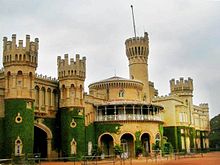
Upon the passing of Tipu Sultan, the Wodeyars returned to the throne of Mysore, and therefore Bangalore, although only as figureheads. Bengaluru remained part of British East India until Indian independence in August 1947.
The 'Residency' of Mysore State was first established at Mysore in 1799 and later shifted to Bengaluru in the year 1804. It was abolished in the year 1843 only to be revived in 1881 at Bengaluru and finally to be closed down in 1947 with the departure of the British. (https://web.archive.org/web/20120206190404/http://rajbhavan.kar.nic.in/history/fromresi-rajbhavan.htm)
The British troops which were first stationed at Srirangapatna after the fall of Tipu Sultan in 1799 were later shifted to the Civil and Military Station of Bangalore in 1809.
The salubrious climate of Bangalore attracted the ruling class and led to the establishment of the famous Military Cantonment, a city-state close to the old town of Bangalore. The area became not only a military base for the British but also a settlement for a large number of Europeans, Anglo-Indians and missionaries.
In Cantonment, the names of many of its streets are derived from military nomenclature — Artillery Road, Brigade Road, Infantry Road and Cavalry Road. The South Parade (now known as Mahatma Gandhi Road) was to the south of the Parade Ground. The Plaza theatre was constructed in the year 1936 on the South Parade and was used by the soldiers for viewing Hollywood movies. The British representative maintained a residence within the cantonment area and his quarters was called the Residency and hence the name Residency Road. Around 1883, three developments were added to the cantonment – Richmond Town, Benson Town and Cleveland Town.
The Cantonment has retained it distinct atmosphere through the years with large populations of Anglo-Indians and Tamils from the British era.

The lack of water supplies within the city of Bangalore was first tackled in 1873 by building a chain of tanks called Miller's Tanks in the Cantonment area. Prior to this water was pumped from the Halsoor, Shoolay and Pudupacherry tanks which were insufficient for the Civil and Military Station. The city area drew water from a Karanjee system from Dharmambudhi and Sampangi tanks. The Great Famine of 1875-77 [14] and the failure of the monsoons led to drying of all these water bodies. During this time water carriers Bihistis supplied water. In 1882 the Sankey Reservoir was constructed at the cost of ₹5.75 Lakhs by Richard Hieram Sankey and collected rain water from an area of 2.5 square miles (6.5 km2). The water was said to be unsavoury and impure. On 23 June 1896 water was pumped from the Chamarajendra Reservoir (Hessarghatta) which dammed the waters of the Arkavathi. This tank went dry for one year in 1925. It was built at the cost of ₹20,78,641. On 15 March 1933, the Thippagondanahalli Reservoir was put into service. On 21 May 1961, the Integrated Water Supply Scheme was inaugurated. This system collected water from the Cauvery river near Halgur and pumped up at Thorekadanahalli, Voddaradoddi, Gantakanadoddi and Tatguni and stored in reservoirs at Mount Joy, Byrasandra and High Grounds. [15]
Bangalore was hit by a plague epidemic in 1898. [16] The epidemic took a huge toll and many temples were built during this time, dedicated to the goddess Mariamma. The crisis caused by this epidemic catalyzed the improvement and sanitation of Bengaluru and, in turn, improvements in sanitation and health facilities helped to modernize Bengaluru.
Telephone lines were laid to help coordinate anti-plague operations. Regulations for building new houses with proper sanitation facilities came into effect. A health officer was appointed in 1898, the city was divided into four wards for better coordination and the Victoria Hospital was inaugurated in 1900 by Lord Curzon, Viceroy and Governor-General of British India.
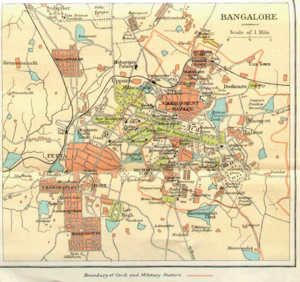
Sometimes it is claimed that, in 1906, Bangalore became the first city in Asia to have electricity, supplied by the hydroelectric plant situated in Shivanasamudra. This information is controversial, as the first electric power supply was started in Kolkata in the year of 1898, to the then Bank of Bengal.
Basavanagudi (named either after the Basavanna Temple or the Bull Temple in the village of Sunkenahalli) and Malleshwaram (named after the Kadu Malleshwara Temple in the old Mallapura village) were created during this time. Kalasipalyam (near the old fort) and Gandhinagar were created between 1921–1931.
Bangalore's reputation as the Garden City of India began in 1927 with the Silver Jubilee celebrations of the rule of Krishnaraja Wodeyar IV. Several projects such as the construction of parks, public buildings and hospitals were instituted to improve the city. [17] Bangalore therefore served traditionally as a retreat for people from the surrounding South Indian regions. Even today, the city administration manages to maintain several parks. Cubbon Park and Lal Bagh are two such examples.
After Indian independence in August 1947, Bangalore remained in the Mysore State of which the Maharaja of Mysore was the Rajapramukharu. [17]

Bangalore continued to be the capital of the unified and linguistically homogeneous Kannada-speaking new Mysore state that was created in 1956, and renamed to Karnataka in 1973.
Kumara Park came into existence in 1947 and Jayanagar in 1948. In the 1960s and 1970s an elite neighborhood was developed in the former gardens of the Bangalore Palace, which was known as "Palace Orchards" now called Sadhashivnagar. The area is now home to many of the wealthy members of Bangalore society, celebrities and politicians.
Public sector employment and education provided opportunities for Kannadigas from the rest of the state to migrate to the city. In the decades that followed, Bangalore's manufacturing base continued to expand with the establishment of private companies such as MICO (Motor Industries Company), which set up its manufacturing plant in the city. Industrialization created further growth that extended from the Peenya Industrial Area in the west to Indiranagar and Whitefield in the east; from Yelahanka Town in the north, to J.P. Nagar in the south.
Bangalore experienced a growth in its real estates e market in the 1980s and 1990s, spurred by capital investors from other parts of the country who converted Bangalore's large plots and colonial bungalows into multi-storied apartments. In 1985, Texas Instruments became the first multinational corporation to set up base in Bangalore. Other information technology companies followed suit, and, by the end of the 20th century, Bangalore had firmly established itself as the Silicon Valley of India.
With an estimated population of 8.5 million in 2011, [18] Bangalore is now the fourth most populous city in India and the 28th most populous city in the world. [19] Bangalore was the fastest-growing Indian metropolis after New Delhi between 1991–2001.
In 2005, the Government of Karnataka announced it had accepted a proposal to rename Bangalore to Bengaluru. [20] In 2006, the Bruhat Bengaluru Mahanagara Palike (BBMP), the third level of government, passed a resolution to implement the proposed name change. [21] However, this process had been stalled due to delays in getting clearances from the Union Home Ministry. [22] In 2014, Union ministry approved the name change to Bengaluru. [23]
| Year | Pop. | ±% |
|---|---|---|
| 1871 | 142,513 | — |
| 1881 | 155,857 | +9.4% |
| 1891 | 180,366 | +15.7% |
| 1901 | 159,030 | −11.8% |
| 1911 | 189,485 | +19.2% |
| 1921 | 237,496 | +25.3% |
| 1931 | 306,470 | +29.0% |
| 1941 | 406,760 | +32.7% |
| 1951 | 778,977 | +91.5% |
| 1961 | 1,199,931 | +54.0% |
| 1971 | 1,653,779 | +37.8% |
| 1981 | 2,913,537 | +76.2% |
| 1991 | 3,628,165 | +24.5% |
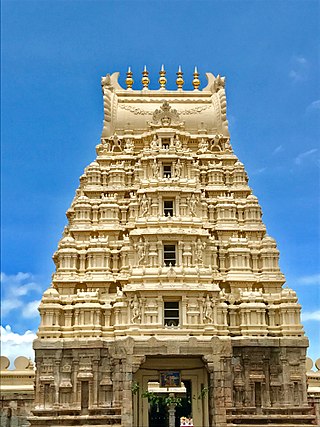
Srirangapatna is a town and headquarters of one of the seven Taluks of Mandya district, in the Indian State of Karnataka. It gets its name from the Ranganthaswamy temple consecrated around AD 984. Later, under the British rule, the city was renamed to Seringapatnam. Located near the city of Mandya, it is of religious, cultural and historic importance.

The Kingdom of Mysore was a realm in the southern part of Deccan Plateau traditionally believed to have been founded in 1399 by two Hindu brothers, in the vicinity of the modern city of Mysore. From 1799 until 1950, it was a princely state, until 1947 in a subsidiary alliance with British India. The British took direct control over the princely state in 1831. Upon accession to the Dominion of India, it became Mysore State, later uniting with other Kannada speaking regions to form the state of Karnataka, with its ruler remaining as Rajapramukh until 1956, when he became the first governor of the reformed state.

Mysore district, officially Mysuru district, is an administrative district located in the southern part of the state of Karnataka, India. It is the administrative headquarters of Mysore division. Chamarajanagar District was carved out of the original larger Mysore District in the year 1998. The district is bounded by Chamrajanagar district to the southeast, Mandya district to the east and northeast, Kerala state to the south, Kodagu district to the west, and Hassan district to the north.

Kempe Gowda I locally venerated as Nadaprabhu Kempe Gowda, or commonly known as Kempe Gowda, was a governor under the Vijayanagara Empire in early-modern India. He is famous for the development of Bangalore Town in the 16th century. Kempegowda erected many Kannada inscriptions across the region. He also authored Ganga-gauri-vilasa, a yakshagana (verse-play) in Telugu. He is commemorated with various statues and memorials and many places are named after him in Bangalore.

Devanahalli, also called "Devandahalli", "Dyaavandalli", Devanadoddi, and Devanapura, is a town and Town Municipal Council in Bengaluru Rural district in the state of Karnataka in India. The town is located 40 kilometres (25 mi) to the north-east of Bengaluru. Devanahalli is the site of Kempegowda International Airport. A multibillion-dollar Devanahalli Business Park with two IT Parks are coming up on nearly 400 acres (1.6 km2) adjoining the airport. An Aerospace Park, Science Park and a ₹10 billion (US$130 million) Financial City are also coming up. A new satellite ring road will connect the city with Doddaballapur. Devanahalli is situated near the upcoming ₹1,500 billion (US$19 billion), 12,000-acre (49 km2) BIAL IT Investment Region, to be the largest IT region in India.
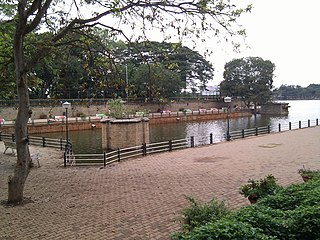
Sadashivanagara is an affluent residential neighbourhood in the northern part of Bangalore in the Indian state of Karnataka. The neighbourhood houses plush homes and mansions of several famous celebrities, businessmen and politicians. It is part of the Bangalore North Lok Sabha constituency and the Malleshwaram Assembly Constituency.
Bangalore is the capital and the largest city of the Indian state of Karnataka. It is India's third largest city and fifth largest metropolitan area. Modern Bengaluru was founded in 1537 CE by Kempe Gowda, a vassal of the Vijayanagara Empire. Kempe Gowda built a mud fort in the vicinity of modern Bengaluru. By 1831, the city was incorporated into the British Raj with the establishment of the Bangalore Cantonment. The British returned dominion of the city to the King of Mysore, choosing however, to retain jurisdiction over the cantonment. Therefore, Bengaluru essentially became a twin city, with civic and infrastructural developments of the cantonment conforming to European styles of planning. For most of the period after Indian independence in 1947, Bengaluru was a B-1 status city, and was not considered to be one of India's "4 major metropolitan cities". The growth of Information Technology in the city, which is the largest contributor to India's software exports, has led to a decadal growth that is second to only that of India's capital New Delhi. The city's roads, however, were not designed to accommodate the vehicular traffic, growing at an average of 8% annually, that prevails in Bengaluru. This leads to heavy slow traffic and traffic jams in Bengaluru Foreign visitors are often shocked to see the state of infrastructure. Particularly during the monsoon season, commute becomes a challenge. The crippling infrastructure and lack of a robust mass transit network have led to the city having one of the worst average commute times in the world.
The Bangalore Cantonment (1806–1881) was a military cantonment of the British Raj based in the Indian city of Bangalore. The cantonment covered an area of 13 square miles (34 km2), extending from the Residency on the west to Binnamangala on the east and from the Tanneries on Tannery Road in the north to AGRAM in the south. By area, it was the largest British military cantonment in South India. The British garrison stationed in the cantonment included three artillery batteries, and regiments of the cavalry, infantry, sappers, miners, mounted infantry, supply and transport corps and the Bangalore Rifle Volunteers. The Bangalore Cantonment was directly under the administration of the British Raj, while Bangalore City itself was under the jurisdiction of the Durbar of the Kingdom of Mysore.

Malleshwaram is a northwest neighborhood and one of the zones of Bruhat Bengaluru Mahanagara Palike in Bengaluru, India. It was planned in 1889 after the great plague of 1898, developed as a suburb in 1892 and handed over to the city municipality in 1895. As per the 1878 Survey of India map, the area came under the village of Ranganatha Palya and was later named after the Kadu Malleshwara Temple. The neighbourhood houses many offices, one them being World Trade Center Bengaluru. It has two shopping malls, Mantri Square and Orion Mall. As an education hub,it houses the education boards of the state KSEEB and PU boards,Mysore Education Society and Indian Institute of Science.
The History of Karnataka goes back several millennia. Several great empires and dynasties have ruled over Karnataka and have contributed greatly to the history, culture and development of Karnataka as well as the entire Indian subcontinent. The Chindaka Nagas of central India Gangas, Rashtrakutas of Manyakheta, Chalukyas of Vengi, Yadava Dynasty of Devagiri were all of Kannada origin who later took to encouraging local languages.

Bangalore Fort began in 1537 as a mud fort. The builder was Kempe Gowda I, a vassal of the Vijaynagar Empire and the founder of Bangalore. Hyder Ali in 1761 replaced the mud fort with a stone fort and it was further improved by his son Tipu Sultan in the late 18th century. It was damaged during an Anglo-Mysore war in 1791. It still remains a good example of 18th-century military fortification. The army of the British East India Company, led by Lord Cornwallis on 21 March 1791 captured the fort in the siege of Bangalore during the Third Mysore War (1790–1792). At the time the fort was a stronghold for Tipu Sultan. Today, the fort's Delhi gate, on Krishnarajendra Road, and two bastions are the primary remains of the fort. A marble plaque commemorates the spot where the British breached fort's wall, leading to its capture. The old fort area also includes Tipu Sultan's Summer Palace, and his armoury. The fort has provided the setting for the treasure hunt in the book Riddle of the Seventh Stone.
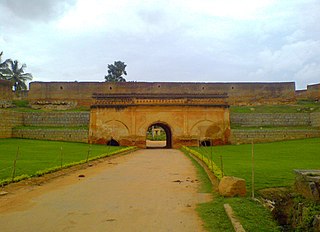
Devanahalli Fort is located 35 kilometers (22 mi) north of Bangalore city, at Devanahalli in the State of Karnataka, India. Chieftain Malla Byre Gowda of Avathi, a Vijayanagara empire vassal, built a mud fort in c. 1501 at Devanadoddi. In the late 18th century, Hyder Ali re-constructed the fort in stone resulting in the current structure.

Bengaluru Pete is the area of Bangalore city which was established by Kempegowda I in 1537 with roads laid out in the cardinal directions, and entrance gates at the end of each road. Kempegowda also termed the Pete he built as his "gandu bhoomi" or "Land of Heroes". Pete forms a well–defined body of markets which were associated with various trades and professions of the populace in the locality markets and given the names of trades pursued in such markets. The well known markets are the Tharagupete–market for grains, the Balepete – for Bangles and musical instruments, the Chikkapete and the Nagarthpete for textile trade, the Ballapurpete and the Ganigarapete market where oil is extracted by people of the Ganiga community, the Tigalarapete–flower market of gardeners, the Cubbonpete – textile manufacture by people of the Devanga community.
Bangalore (Bengaluru), the capital of Karnataka state, India, reflects its multireligious and cosmopolitan character by its more than 1000 temples, 400 mosques, 100 churches, 40 Jain derasars, three Sikh gurdwaras, two Buddhist viharas and one Parsi fire temple located in an area of 741 km2 of the metropolis. The religious places are further represented to include the few members of the Jewish community who are making their presence known through the Chabad that they propose to establish in Bangalore and the fairly large number of the Baháʼí Faith whose presence is registered with a society called the Baháʼí Centre. In the demographically diverse, major economic hub and India's fastest-growing major metropolis of Bangalore, the number of religious places of each religion reported reflects growth in proportion to the population growth. According to the 2001 census of India, 79.37% of Bangalore's population is Hindu, roughly the same as the national average. Muslims comprise 13.37% of the population, which again is roughly the same as the national average, while Christians and Jains account for 5.79% and 1.05% of the population, respectively, double that of their national averages. Anglo-Indians also form a substantial group within the city.

The name Karnataka is derived from Karunadu, meaning 'lofty land' or 'high plateau', due to its location on the Deccan Plateau. The name can also mean 'land of black soil' in Kannada. There are other possible roots of the name. The recorded history of Karnataka goes back to the Ramayana and Mahabharata epics. The capital of "Baali" and "Sugriva" referenced in the Ramayana is said to be Hampi. Karnataka is mentioned in the Mahabharata as "Karnata Desha"." Historically, the region was also called "Kuntala Rajya".

The Ranganatha Swamy and the Someshwara temples are located in the historic town of Magadi, about 41 km from Bangalore, the capital of the Indian state of Karnataka. These temples are protected monuments under the Karnataka state division of the Archaeological Survey of India.

The Karnataka Tamils are a social community of Tamil language speakers living in Bangalore, capital city of the Indian state of Karnataka and Mysore, Mandya, Kolar Gold Fields, Chamrajnagar, and other districts of old Mysore Kingdom. According to The Hindu newspaper, Tamil-speaking settlers migrated to Bangalore in four major waves, the first after the 10th century; the second during the Vijayanagara period; and the third, in the 18th century, after the need for government service required by British East India Company who built the train tracks in Bangalore. Lastly now most Tamilians move to Bangalore for work. However some may say both kannadiga and Tamil were there from the first. According to census 1991, people speaking Tamil as mother tongue in Bangalore formed about 21%. There are 2.1 million Tamils living in Karnataka as of 2011 Census report.

Bangalore, officially Bengaluru, is the capital and largest city of the southern Indian state of Karnataka. It has a population of more than 8 million and a metropolitan population of around 15 million, making it India's third most populous city and fourth most populous urban agglomeration. It is the most populous city and largest urban agglomeration in South India, and is the 27th largest city in the world. Located on the Deccan Plateau, at a height of over 900 m (3,000 ft) above sea level, Bangalore has a pleasant climate throughout the year, with its parks and green spaces earning it the reputation of India's "Garden City". Its elevation is the highest of India's major cities.

Masjid-i-Ala is a mosque located inside the Srirangapatna Fort in Srirangapatna in Mandya District in Karnataka. It was built in 1786–87, during the rule of Tipu Sultan.